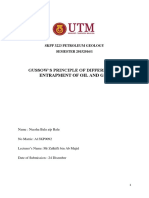1-Basic Log Interpretation
Uploaded by
Hafiz Asyraf1-Basic Log Interpretation
Uploaded by
Hafiz AsyrafA
Reservoir Rocks
Introduction to Log Interpretation
Schlumberger 1999
1 1
Reservoir Rocks
Log Interpretation
Interpretation is defined as the action of explaining the meaning of something. Log Interpretation is the explanation of logs b, GR, Resistivity, etc. in terms of well and reservoir parameters, zones, porosity, oil saturation, etc. Log interpretation can provide answers to questions on:
2 2
Reservoir Rocks
Why Run Logs
3 3
Reservoir Rocks
The Reservoir
4 4
Reservoir Rocks
Requirements of a reservoir
To form a reservoir needs - source of organic material (terrestrial or marine) - a suitable combination of heat, pressure and time
- an oxygen free environment
- a suitable basin
5 5
Reservoir Rocks
Reservoir Geometry
6 6
Reservoir Rocks
Reservoir Rocks
Schlumberger 1999
7 7
Reservoir Rocks
Rocks General
There are three major classes of rock: Igneous: (e.g. Granite).
Sedimentary:
(e.g. Sandstone). Metamorphic: (e.g. Marble).
8 8
Reservoir Rocks
Rock Cycle
9 9
Reservoir Rocks
Igneous Rocks
Comprise 95% of the Earth's crust. Originated from the solidification of molten material from deep inside the Earth. There are two types: Volcanic - glassy in texture due to fast cooling. Plutonic - slow-cooling, crystalline rocks.
10 10
Reservoir Rocks
Igneous Rocks and Reservoirs
Igneous rocks can be part of reservoirs. Fractured granites form reservoirs in some parts of the world. Volcanic tuffs are mixed with sand in some reservoirs.
Example: Granite Wash - Elk City, Okla., Northern Alberta,CA
11 11
Reservoir Rocks
Metamorphic Rocks
2) Metamorphic rocks formed by the action of temperature and/or pressure on sedimentary or igneous rocks. Examples are Marble Hornfels Gneiss formed from limestone from shale or tuff similar to granite but formed by metamorphosis
Field Example: 1. Point Arguello - Monterey Formation is actually layers of fractured Chert and Shale. Oil is in the fractures 2. Long Beach, Calif. - Many SS producers on an Anticline above fractured Metamorphic basement rock 3. Austin, TX eastward - Lava flows of Basalt (Serpentine) from Volcanoes in ancient Gulf of Mexico
12 12
Reservoir Rocks
Sedimentary Rocks
The third category is Sedimentary rocks. These are the most important for the oil industry as it contains most of the source rocks and cap rocks and virtually all reservoirs. Sedimentary rocks come from the debris of older rocks and are split into two categories Clastic and Non-clastic. Clastic rocks - formed from the materials of older rocks by the actions of erosion, transportation and deposition. Non-clastic rocks from chemical or biological origin and then deposition.
13 13
Reservoir Rocks
Depositional Environments
The depositional environment can be Shallow or deep water. Marine (sea) and lake or continental. This environment determines many of the reservoir characteristics
Frigg Gas Field North Sea
14 14
Reservoir Rocks
Depositional Environments 2
Continental deposits are usually dunes. A shallow marine environment has a lot of turbulence hence varied grain sizes. It can also have carbonate and evaporite formation. A deep marine environment produces fine sediments.
15 15
Reservoir Rocks
Depositional Environments 3
The depositional characteristics of the rocks lead to some of their properties and that of the reservoir itself. The reservoir rock type clastic or non-clastic. The type of porosity (especially in carbonates) is determined by the environment plus subsequent events. The structure of a reservoir can also be determined by deposition; a river, a delta, a reef and so on. This can also lead to permeability and producibility. of these properties are often changed by further events.
16 16
Reservoir Rocks
Depositional Environment 4
The environment is not static. Folding and faulting change the structure. Dissolution and fracturing can change the permeability.
17 17
Reservoir Rocks
Clastic Rocks
Clastic rocks are sands, silts and shales. The difference is in the size of the grains.
18 18
Reservoir Rocks
Sedimentation
Sediments settle to the bottom of the sedimentary basin.
As the sediments accumulate the temperature and pressure increase expelling water from the sediments.
19 19
Reservoir Rocks
Sedimentation 2
Sedimentary muds become sedimentary rocks. Calcareous muds become limestone. Sands become sandstone. Another effect involves both the grains in the matrix and the fluids reacting to create new minerals changing the matrix and porosity. Fluids can also change creating a new set of minerals.
This whole process is called Diagenesis.
20 20
Reservoir Rocks
Depositional Environment - Delta
Sediments are transported to the basins by rivers. A common depositional environment is the delta where the river empties into the sea. A good example of this is the Mississippi.
21 21
Reservoir Rocks
Rivers
Some types of deposition occur in rivers and sand bars. The river forms a channel where sands are deposited in layers. Rivers carry sediment down from the mountains which is then deposited in the river bed and on the flood plains at either side. Changes in the environment can cause these sands to be overlain with a shale, trapping the reservoir rock.
22 22
Reservoir Rocks
Carbonates
Carbonates form a large proportion of all sedimentary rocks.
They consist of: Limestone. Dolomite.
Carbonates usually have an irregular structure.
23 23
Reservoir Rocks
Carbonate types
Chalk is a special form of limestone and is formed from the skeletons of small creatures (cocoliths). Dolomite is formed by the replacement of some of thecalcium by a lesser volume of magnesium in limestone by magnesium. Magnesium is smaller than calcium, hence the matrix becomes smaller and more porosity is created. Limestone CaCO3
Dolomite
CaMg(CO3)2
Evaporites such as Salt (NaCl) and Anhydrite (CaSO4) can also form in these environments.
24 24
Reservoir Rocks
Depositional Environment Carbonates
Carbonates are formed in shallow seas containing features such as:
Reefs.
Lagoons. Shore-bars.
25 25
Reservoir Rocks
Rock Properties
Rocks are described by three properties: Porosity quantity of pore space
Permeability - ability of a formation to flow
Matrix -
major constituent of the rock
26 26
Reservoir Rocks
Definition of Porosity
27 27
Reservoir Rocks
Porosity Sandstones
The porosity of a sandstone depends on the packing arrangement of its grains. The system can be examined using spheres.
In a Rhombohedral packing, the pore space accounts for 26% of the total volume.
With a Cubic packing arrangement, the pore space fills 47% of the total volume.
In practice, the theoretical value is rarely reached because: a) the grains are not perfectly round, and b) the grains are not of uniform size.
28 28
Reservoir Rocks
Porosity and Grain Size
A rock can be made up of small grains or large grains but have the same porosity. Porosity depends on grain packing, not the grain size.
29 29
Reservoir Rocks
Diagenesis
The environment can also involve subsequent alterations of the rock such as: Chemical changes. Diagenesis is the chemical alteration of a rock after burial. An example is the replacement of some of the calcium atoms in limestone by magnesium to form dolomite.
Mechanical changes - fracturing in a tectonically-active region.
30 30
Reservoir Rocks
Carbonate Porosity Types 1
Carbonate porosity is very heterogeneous. It is classified into a number of types: Interparticle porosity: Each grain is separated, giving a similar pore space arrangement as sandstone. Intergranular porosity: Pore space is created inside the individual grains which are interconnected. Intercrystalline porosity: Produced by spaces between carbonate crystals. Mouldic porosity: Pores created by the dissolution of shells, etc.
31 31
Reservoir Rocks
Carbonate Porosity Types 2
Fracture porosity: Pore spacing created by the cracking of the rock fabric.
Channel porosity: Similar to fracture porosity but larger.
Vuggy porosity: Created by the dissolution of fragments, but unconnected.
32 32
Reservoir Rocks
Carbonate Porosity
Intergranular porosity is called "primary porosity".
Porosity created after deposition is called "secondary porosity".
The latter is in two forms: Fractures Vugs.
33 33
Reservoir Rocks
Fractures
Fractures are caused when a rigid rock is strained beyond its elastic limit - it cracks. The forces causing it to break are in a constant direction, hence all the fractures are also aligned. Fractures are an important source of permeability in low porosity carbonate reservoirs.
34 34
Reservoir Rocks
Vugs
Vugs are defined as non-connected pore space. They do not contribute to the producible fluid total. Vugs are caused by the dissolution of soluble material such as shell fragments after the rock has been formed. They usually have irregular shapes.
35 35
Reservoir Rocks
Permeability Definition
The rate of flow of a liquid through a formation depends on: The pressure drop. The viscosity of the fluid. The permeability.
The pressure drop is a reservoir property. The viscosity is a fluid property. The permeability is a measure of the ease at which a fluid can flow through a formation. Relationships exist between permeability and porosity for given formations, although they are not universal. A rock must have porosity to have any permeability. The unit of measurement is the Darcy. Reservoir permeability is usually quoted in millidarcies, (md).
36 36
Reservoir Rocks
Darcy Experiment
The flow of fluid of viscosity m through a porous medium was first investigated in 1856 by Henri Darcy. He related the flow of water through a unit volume of sand to the pressure gradient across it. In the experiment the flow rate can be changed by altering the parameters as follows:
37 37
Reservoir Rocks
Darcy Law
K = permeability, in Darcies. L = length of the section of rock, in centimetres. Q = flow rate in centimetres3 / sec. P1, P2 = pressures in bars. A = surface area, in cm2. = viscocity in centipoise.
38 38
Reservoir Rocks
Permeability and Rocks
In formations with large grains, the permeability is high and the flow rate larger.
39 39
Reservoir Rocks
Permeability and Rocks 2
In a rock with small grains the permeability is less and the flow lower.
Grain size has no bearing on porosity, but has a large effect on permeability.
40 40
Reservoir Rocks
Reservoir Rocks
Reservoir rocks need two properties to be successful: Pore spaces able to retain hydrocarbon. Permeability which allows the fluid to move.
41 41
Reservoir Rocks
Clastic Reservoirs
Sandstone usually has regular grains; and is referred to as a grainstone. Porosity Determined mainly by the packing and mixing of grains. Permeability Determined mainly by grain size and packing, connectivity and shale content.
Fractures may be present.
42 42
Reservoir Rocks
Carbonate Reservoirs
Carbonates normally have a very irregular structure. Porosity: Determined by the type of shells, etc. and by depositional and post-depositional events (fracturing, leaching, etc.). Permeability: Determined by deposition and postdeposition events, fractures.
Fractures can be very important in carbonate reservoirs.
43 43
Reservoir Rocks
Cap Rock
A reservoir needs a cap rock.
Impermeable cap rock keeps the fluids trapped in the reservoir. It must have zero permeability. Some examples are: Shales. Evaporites such as salt or anhyhdrite. Zero-porosity carbonates.
44 44
Reservoir Rocks
Source Rocks
Hydrocarbon originates from minute organisms in seas and lakes. When they die, they sink to the bottom where they form organic-rich "muds" in fine sediments. These "muds" are in a reducing environment or "kitchen", which strips oxygen from the sediments leaving hydrogen and carbon. The sediments are compacted to form organicrich rocks with very low permeability. The hydrocarbon can migrate very slowly to nearby porous rocks, displacing the original formation water.
45 45
Reservoir Rocks
Hydrocarbon Migration
Hydrocarbon migration takes place in two stages: Primary migration - from the source rock to a porous
rock. This is a complex process and not fully understood. It is probably limited to a few hundred metres.
Secondary migration - along the porous rock to the trap.
This occurs by buoyancy, capillary pressure and hydrodynamics through a continuous water-filled pore system. It can take place over large distances.
46 46
Reservoir Rocks
Rock Classification
Clastics Rock type Conglomerate Sandstone Siltstone Shale Non-Clastics Rock type
Particle diameter Pebbles Sand Silt Clay 2 - 64mm .06 - 2mm .003 - .06mm <.003mm
Composition
Limestone Dolomite Salt Anhydrite Gypsum Coal
CaCO3 CaMg(CO3)2 NaCl CaSO4 CaSO4.2H2O Carbon
47 47
Reservoir Rocks
Reservoir Structure
There are many other types of structure. The criteria for a structure is that it must have: Closure, i.e. the fluids are unable to escape. Be large enough to be economical.
The exact form of the reservoir depends on the depositional environment and post depositional events such as foldings and faulting.
48 48
Reservoir Rocks
Traps General
Ghawar Oilfield - Saudi Arabia- Ls - 145 mi x 13 mi wide x260 ft produces 11,000 b/d total 82B bbls Gasharan Oilfield - Iran - Ls - 6000ft. Net pay total 8.5 B bbls
49 49
Reservoir Rocks
Structural Traps
The simplest form of trap is a dome. This is created by upward movement or folding of underlying sediments.
An anticline is another form of simple trap. This is formed by the folding of layers of sedimentary rock.
50 50
Reservoir Rocks
Fault Traps
Faults occur when the rock shears due to stresses. Reservoirs often form in these fault zones. A porous and permeable layer may trap fluids due to its location alongside an impermeable fault or its juxtaposition alongside an impermeable bed. Faults are found in conjunction with other structures such as anticlines, domes and salt domes.
Drag Faults - Wyoming, most Rocky Mountains
Normal Faults - Nigeria, Hibenia (E. Canada), Vicksburg Trends (Victoria, TX)
51 51
Reservoir Rocks
Salt Dome Trap
Salt Dome traps are caused when "plastic" salt is forced upwards. The salt dome pierces through layers and compresses rocks above. This results in the formation of various traps: In domes created by formations pushed up by the salt. Along the flanks and below the overhang in porous rock abutting on the impermeable salt itself.
Example: Gulf of Mexico, Spindletop,TX, North Sea (Ekofisk Dome with fractured Chalk as reservoir rock)
52 52
Reservoir Rocks
Stratigraphic Traps
Michigan - Belle River Mills Devonian reefs (Barriers and Atolls) - Alberta CA. (Leduc & Redwater) Midland Basin &Delaware Basin of West TX - Barrier Reefs
Point Bars - Powder River Basin, WY, Clinton SS in Western Ok,
53 53
Reservoir Rocks
Reservoir Mapping
Reservoir contours are usually measured to be below Mean Sea Level (MSL). They can represent either the reservoir formation structure or fluid layers.
54 54
Reservoir Rocks
Wireline Well Logging
The Wellbore Wellbore Fluids Volumes Under Investigation Basic Interpretation Technique Interpretation Procedures
55 55
Reservoir Rocks
Measuring in the borehole
The formation to be measured is masked by the borehole. The borehole contains fluids and is of an irregular shape.
Formatio n to be Measu red
Sensors + El ectroni cs
Borehol e
The sensor has to be able to measure the formation property accurately and send the information to surface.
56 56
Reservoir Rocks
Borehole -Size and Shape
Perfect shape no problems except if very large.
Ovalised hole; will give problems for some tools. Best to run two calipers.
Irregular borehole, gives problems for most tools.
57 57
Reservoir Rocks
Tool Positioning - 1
Some tools are run centralised in the borehole in order to measure properly. These include laterolog and sonic devices. Special centralisers are put on the tool.
Formatio n to be Measu red
Centra li sed Tool
58 58
Reservoir Rocks
Tool Positioning - 2
Some tools are run eccentred, pushed, against the borehole wall.
Eccentral ised Tool
In some cases this is done with an eccentraliser. In other cases a caliper arm does this job.
Formatio n to be Measu red
59 59
Reservoir Rocks
Tool Positioning - 3
Some tools are run with stand-offs to position them at a fixed distance from the wall.
Tool with Stand-offs
The induction family are usually run in this manner.
Formatio n to be Measu red
Stand-Offs
60 60
Reservoir Rocks
Borehole fluids 2
Oil based mud will not allow current to pass so electrical logs will not work. Foam and air muds will not transmit sonics signals. Neutron tools are also affected.
Mud salinity affects electrical and induction tools in different manners.
Additives such as barite affect density, gamma ray and photoelectric effect measurements. The mud type, salinity and additives must be known so that the appropriate corrections can be made.
61 61
Reservoir Rocks
Borehole - Temperature
Increasing temperature affects the measurements in some tools. The most affected is the thermal neutron devices.
High temperature also affect the performance of the electronics in the tools.
Temperature affects the mud resistivity (it decreases with increasing temperature).
Temperature is measured during each logging run.
62 62
Reservoir Rocks
Volume of Investigation
The tool shown here measures all around the borehole. It is omni-directional.
An example of this type of tool is the Gamma Ray.
Some of the signal is in the borehole. Most comes from the invaded zone.
63 63
Reservoir Rocks
Volume of Investigation 3
Formati on to be Measured
Vi rgi n Zone
Vi rgi n Zone
Vol ume i nvesti gate d by the too l
Invaded Zone
This type of measurement has the sensor facing in one direction only.
Examples of this are the neutron porosity and bulk density measurements.
64 64
Reservoir Rocks
Vertical Wells
In vertical wells, with homogeneous layers all types of tool are reading in the same formation.
In horizontal (or highly deviated) wells the deep reading resistivity tools may read a different layer to the shallow reading tools.
In addition the omni-directional tools (e.g. GR) may read different layers from the single direction devices.
65 65
Reservoir Rocks
Drilling Objective
A well is drilled to a pre-determined objective:
An exploration well targets a suspected reservoir.
An appraisal well evaluates a discovery.
A development well is used for production.
66 66
Reservoir Rocks
Pre-Drilling Knowledge Exploration
Structural information obtained from surface seismic data. Rough geological information can be provided by nearby wells or outcrops. Approximate depths estimated from surface seismic data.
67 67
Reservoir Rocks
Tool History
1927 - First electrical log recorded. 1930s - SP, Short Normal, Long Normal and Long Lateral combined, Core Sample Taker. 1940s - Gamma Ray and Neutron, 3-arm Dipmeter using SP, then electrical measurements, Induction tool. 1950s - Microlog tool, Laterolog tool, Sonic tool, Formation Tester. 1960s - Formation Density tool. 1970s - Dual Spacing Neutrons, Advanced Dipmeters, Computerised Surface Systems, Repeat Tester tools, Electromagnetic Propagation tool. 1980s - Resistivity Imaging tool, Advanced Sonic tools 1990s - Advanced testing tools, Induction imaging tools, Azimuthal Laterolog tools, Ultrasonic imaging tools, Epithermal porosity tools, Magnetic resonance tools
68 68
Reservoir Rocks
Early Interpretation
Early resistivity logs were used to find possible producing zones. high resistivity = hydrocarbon
SP was used to define permeable beds, compute Rw and determine shaliness. Resistivity was also used to determine "porosity".
Archie developed the relationship between resistivity, porosity and saturation.
69 69
Reservoir Rocks
Basic Log Response
SP Resistivity Porosity
70 70
Reservoir Rocks
Interpretation Procedure 2
Gamma Ray Resistivity Porosity
Hydrocarbon
Water
Shale
Water
The simplest evaluation technique consists of recognising the hydrocarbon zone using the porosity and resistivity curves
71 71
Reservoir Rocks
Interpretation Procedure
72 72
Reservoir Rocks
Zoning
Zoning is the first step in any interpretation procedure. During zoning, the logs are split into intervals of: 1) Porous and non-porous rock. 2) Permeable and non-permeable rock. 3) Shaly and clean rock. 4) Good hole conditions and bad hole conditions. 5) Good logs and bad logs.
Zoning Tools: SP. GR. Caliper. Neutron Density-Pef. Resistivity.
73 73
You might also like
- Perkins 1103 and 1104c Engines Systems Operation Testing and Adjusting97% (35)Perkins 1103 and 1104c Engines Systems Operation Testing and Adjusting56 pages
- A New Tool For Electro-Facies Analysis: Multi-Resolution Graph-Based Clustering100% (1)A New Tool For Electro-Facies Analysis: Multi-Resolution Graph-Based Clustering14 pages
- Black & Decker The Complete Guide To Landscape Projects97% (34)Black & Decker The Complete Guide To Landscape Projects241 pages
- Well Logging: Principles, Applications and Uncertainties: Nazmul Haque MondolNo ratings yetWell Logging: Principles, Applications and Uncertainties: Nazmul Haque Mondol41 pages
- Crain's Petrophysical Handbook - Total Organic Carbon (TOC)No ratings yetCrain's Petrophysical Handbook - Total Organic Carbon (TOC)21 pages
- ENM200 Reservoir Rock Properties - NotesNo ratings yetENM200 Reservoir Rock Properties - Notes14 pages
- Basic Logging Methods and Formation EvaluationNo ratings yetBasic Logging Methods and Formation Evaluation5 pages
- Fracture Identification by Log IntepretationNo ratings yetFracture Identification by Log Intepretation18 pages
- New Approach To Calculate The Mud Invasion in Reservoirs Using Well Logs - Mariléa RibeiroNo ratings yetNew Approach To Calculate The Mud Invasion in Reservoirs Using Well Logs - Mariléa Ribeiro5 pages
- Determination of Total Organic Carbon Using Multivariate Regression Analysis and Wireline Logs Method at Well X, West Timor, IndonesiaNo ratings yetDetermination of Total Organic Carbon Using Multivariate Regression Analysis and Wireline Logs Method at Well X, West Timor, Indonesia4 pages
- Clay Estimation From GR and Neutron - Density Porosity LogsNo ratings yetClay Estimation From GR and Neutron - Density Porosity Logs15 pages
- Hydrocarbon Production From Fractured Basement Formations100% (1)Hydrocarbon Production From Fractured Basement Formations40 pages
- Crossplots: Fig. 2 - Neutron-Density Crossplot Showing Where The Common Lithologies in Fig. 1 FallNo ratings yetCrossplots: Fig. 2 - Neutron-Density Crossplot Showing Where The Common Lithologies in Fig. 1 Fall4 pages
- A Tutorial On Petrophysical Analysis in Oil SandsNo ratings yetA Tutorial On Petrophysical Analysis in Oil Sands4 pages
- 1 Basic Petrophysics and Schlumberger Techlog100% (1)1 Basic Petrophysics and Schlumberger Techlog2 pages
- Well Logging I Well Logging I: Lecture 4: Sonic LogsNo ratings yetWell Logging I Well Logging I: Lecture 4: Sonic Logs20 pages
- Course Presentation - Management - Day 6 - Week 3100% (1)Course Presentation - Management - Day 6 - Week 330 pages
- Lithology Identification From Porosity LogsNo ratings yetLithology Identification From Porosity Logs21 pages
- Clastic Sedimentology Aeolian Depositional Environment May 2016 1100% (1)Clastic Sedimentology Aeolian Depositional Environment May 2016 138 pages
- Gussow'S Principle of Differential Entrapment of Oil and Gas0% (1)Gussow'S Principle of Differential Entrapment of Oil and Gas13 pages
- Paradigm Webinar Full Waveform Sonic Processing in Geolog - CleanedNo ratings yetParadigm Webinar Full Waveform Sonic Processing in Geolog - Cleaned32 pages
- Petrophysical Interpretation in Shaly Sand Formation of A Gas Field in TanzaniaNo ratings yetPetrophysical Interpretation in Shaly Sand Formation of A Gas Field in Tanzania13 pages
- Integrated Petrophysical Formation Evaluation Using Capture Spectroscopy and NMR On Exploration Well, South Sumatra - IPA05-E-145 - p033 - 047No ratings yetIntegrated Petrophysical Formation Evaluation Using Capture Spectroscopy and NMR On Exploration Well, South Sumatra - IPA05-E-145 - p033 - 04715 pages
- Reservoir Characterization and Rock Typing of Carbonate ReservoirNo ratings yetReservoir Characterization and Rock Typing of Carbonate Reservoir17 pages
- Well-Logging Correlation - Analysis and Correlation of Well Logs in Rio Grande Do Norte Basin WellsNo ratings yetWell-Logging Correlation - Analysis and Correlation of Well Logs in Rio Grande Do Norte Basin Wells8 pages
- Application of Petrophysics in Seismic Interpretation: BY RAJDEEP BURAGOHAIN (R280308025) B.Tech (GSE)100% (1)Application of Petrophysics in Seismic Interpretation: BY RAJDEEP BURAGOHAIN (R280308025) B.Tech (GSE)11 pages
- Razali - Seismic Stratigraphy & CRS MappingNo ratings yetRazali - Seismic Stratigraphy & CRS Mapping136 pages
- Rivers and Floodplains: Forms, Processes, and Sedimentary RecordFrom EverandRivers and Floodplains: Forms, Processes, and Sedimentary RecordNo ratings yet
- Atlas of Structural Geological Interpretation from Seismic ImagesFrom EverandAtlas of Structural Geological Interpretation from Seismic ImagesAchyuta Ayan MisraNo ratings yet
- Geology of Carbonate Reservoirs: The Identification, Description and Characterization of Hydrocarbon Reservoirs in Carbonate RocksFrom EverandGeology of Carbonate Reservoirs: The Identification, Description and Characterization of Hydrocarbon Reservoirs in Carbonate RocksNo ratings yet
- Institute For Research and Urban Planning of CuritibaNo ratings yetInstitute For Research and Urban Planning of Curitiba42 pages
- 2-Urban Rail Development Plan Urdp June2013No ratings yet2-Urban Rail Development Plan Urdp June201371 pages
- SPE-58985-MS-Production Analysis of Commingled Gas Reservoirs - Case HistoriesNo ratings yetSPE-58985-MS-Production Analysis of Commingled Gas Reservoirs - Case Histories10 pages
- 7-Interchange Integration Plan Iip June2013No ratings yet7-Interchange Integration Plan Iip June201347 pages
- Evaluation of Fishing Gear Induced Pipeline Damage: B. King R. DaviesNo ratings yetEvaluation of Fishing Gear Induced Pipeline Damage: B. King R. Davies8 pages
- OTC 5808 Deepwater Drilling: References and Illustrations at End of Paper in A Second Stage Initiated WithNo ratings yetOTC 5808 Deepwater Drilling: References and Illustrations at End of Paper in A Second Stage Initiated With10 pages
- Of Failure, Weak Formations Can Be Strengthened By: Oil, J 0No ratings yetOf Failure, Weak Formations Can Be Strengthened By: Oil, J 09 pages
- SPE-160924-MS - To Develop The Optimum Field Development Plan For Condensate Well Using IPMNo ratings yetSPE-160924-MS - To Develop The Optimum Field Development Plan For Condensate Well Using IPM12 pages
- Production Logging .. Why ?: With PL Sensors, We GetNo ratings yetProduction Logging .. Why ?: With PL Sensors, We Get15 pages
- Control Your Motors With L293D and Arduino PDFNo ratings yetControl Your Motors With L293D and Arduino PDF11 pages
- Boq - Civil+Mep (Sep 2022) - With PriceNo ratings yetBoq - Civil+Mep (Sep 2022) - With Price124 pages
- The Danger of Burning Plastic: Why Are Cancer Rates So High?No ratings yetThe Danger of Burning Plastic: Why Are Cancer Rates So High?8 pages
- Tanquillas Plasticas Gas y Agua CiudadesNo ratings yetTanquillas Plasticas Gas y Agua Ciudades17 pages
- Implementing Multicast Service ReflectionNo ratings yetImplementing Multicast Service Reflection16 pages
- Perkins 1103 and 1104c Engines Systems Operation Testing and AdjustingPerkins 1103 and 1104c Engines Systems Operation Testing and Adjusting
- A New Tool For Electro-Facies Analysis: Multi-Resolution Graph-Based ClusteringA New Tool For Electro-Facies Analysis: Multi-Resolution Graph-Based Clustering
- Black & Decker The Complete Guide To Landscape ProjectsBlack & Decker The Complete Guide To Landscape Projects
- Well Logging: Principles, Applications and Uncertainties: Nazmul Haque MondolWell Logging: Principles, Applications and Uncertainties: Nazmul Haque Mondol
- Crain's Petrophysical Handbook - Total Organic Carbon (TOC)Crain's Petrophysical Handbook - Total Organic Carbon (TOC)
- New Approach To Calculate The Mud Invasion in Reservoirs Using Well Logs - Mariléa RibeiroNew Approach To Calculate The Mud Invasion in Reservoirs Using Well Logs - Mariléa Ribeiro
- Determination of Total Organic Carbon Using Multivariate Regression Analysis and Wireline Logs Method at Well X, West Timor, IndonesiaDetermination of Total Organic Carbon Using Multivariate Regression Analysis and Wireline Logs Method at Well X, West Timor, Indonesia
- Clay Estimation From GR and Neutron - Density Porosity LogsClay Estimation From GR and Neutron - Density Porosity Logs
- Hydrocarbon Production From Fractured Basement FormationsHydrocarbon Production From Fractured Basement Formations
- Crossplots: Fig. 2 - Neutron-Density Crossplot Showing Where The Common Lithologies in Fig. 1 FallCrossplots: Fig. 2 - Neutron-Density Crossplot Showing Where The Common Lithologies in Fig. 1 Fall
- Well Logging I Well Logging I: Lecture 4: Sonic LogsWell Logging I Well Logging I: Lecture 4: Sonic Logs
- Clastic Sedimentology Aeolian Depositional Environment May 2016 1Clastic Sedimentology Aeolian Depositional Environment May 2016 1
- Gussow'S Principle of Differential Entrapment of Oil and GasGussow'S Principle of Differential Entrapment of Oil and Gas
- Paradigm Webinar Full Waveform Sonic Processing in Geolog - CleanedParadigm Webinar Full Waveform Sonic Processing in Geolog - Cleaned
- Petrophysical Interpretation in Shaly Sand Formation of A Gas Field in TanzaniaPetrophysical Interpretation in Shaly Sand Formation of A Gas Field in Tanzania
- Integrated Petrophysical Formation Evaluation Using Capture Spectroscopy and NMR On Exploration Well, South Sumatra - IPA05-E-145 - p033 - 047Integrated Petrophysical Formation Evaluation Using Capture Spectroscopy and NMR On Exploration Well, South Sumatra - IPA05-E-145 - p033 - 047
- Reservoir Characterization and Rock Typing of Carbonate ReservoirReservoir Characterization and Rock Typing of Carbonate Reservoir
- Well-Logging Correlation - Analysis and Correlation of Well Logs in Rio Grande Do Norte Basin WellsWell-Logging Correlation - Analysis and Correlation of Well Logs in Rio Grande Do Norte Basin Wells
- Application of Petrophysics in Seismic Interpretation: BY RAJDEEP BURAGOHAIN (R280308025) B.Tech (GSE)Application of Petrophysics in Seismic Interpretation: BY RAJDEEP BURAGOHAIN (R280308025) B.Tech (GSE)
- Rivers and Floodplains: Forms, Processes, and Sedimentary RecordFrom EverandRivers and Floodplains: Forms, Processes, and Sedimentary Record
- Atlas of Structural Geological Interpretation from Seismic ImagesFrom EverandAtlas of Structural Geological Interpretation from Seismic Images
- Geology of Carbonate Reservoirs: The Identification, Description and Characterization of Hydrocarbon Reservoirs in Carbonate RocksFrom EverandGeology of Carbonate Reservoirs: The Identification, Description and Characterization of Hydrocarbon Reservoirs in Carbonate Rocks
- Institute For Research and Urban Planning of CuritibaInstitute For Research and Urban Planning of Curitiba
- SPE-58985-MS-Production Analysis of Commingled Gas Reservoirs - Case HistoriesSPE-58985-MS-Production Analysis of Commingled Gas Reservoirs - Case Histories
- Evaluation of Fishing Gear Induced Pipeline Damage: B. King R. DaviesEvaluation of Fishing Gear Induced Pipeline Damage: B. King R. Davies
- OTC 5808 Deepwater Drilling: References and Illustrations at End of Paper in A Second Stage Initiated WithOTC 5808 Deepwater Drilling: References and Illustrations at End of Paper in A Second Stage Initiated With
- Of Failure, Weak Formations Can Be Strengthened By: Oil, J 0Of Failure, Weak Formations Can Be Strengthened By: Oil, J 0
- SPE-160924-MS - To Develop The Optimum Field Development Plan For Condensate Well Using IPMSPE-160924-MS - To Develop The Optimum Field Development Plan For Condensate Well Using IPM
- Production Logging .. Why ?: With PL Sensors, We GetProduction Logging .. Why ?: With PL Sensors, We Get
- The Danger of Burning Plastic: Why Are Cancer Rates So High?The Danger of Burning Plastic: Why Are Cancer Rates So High?










































































































